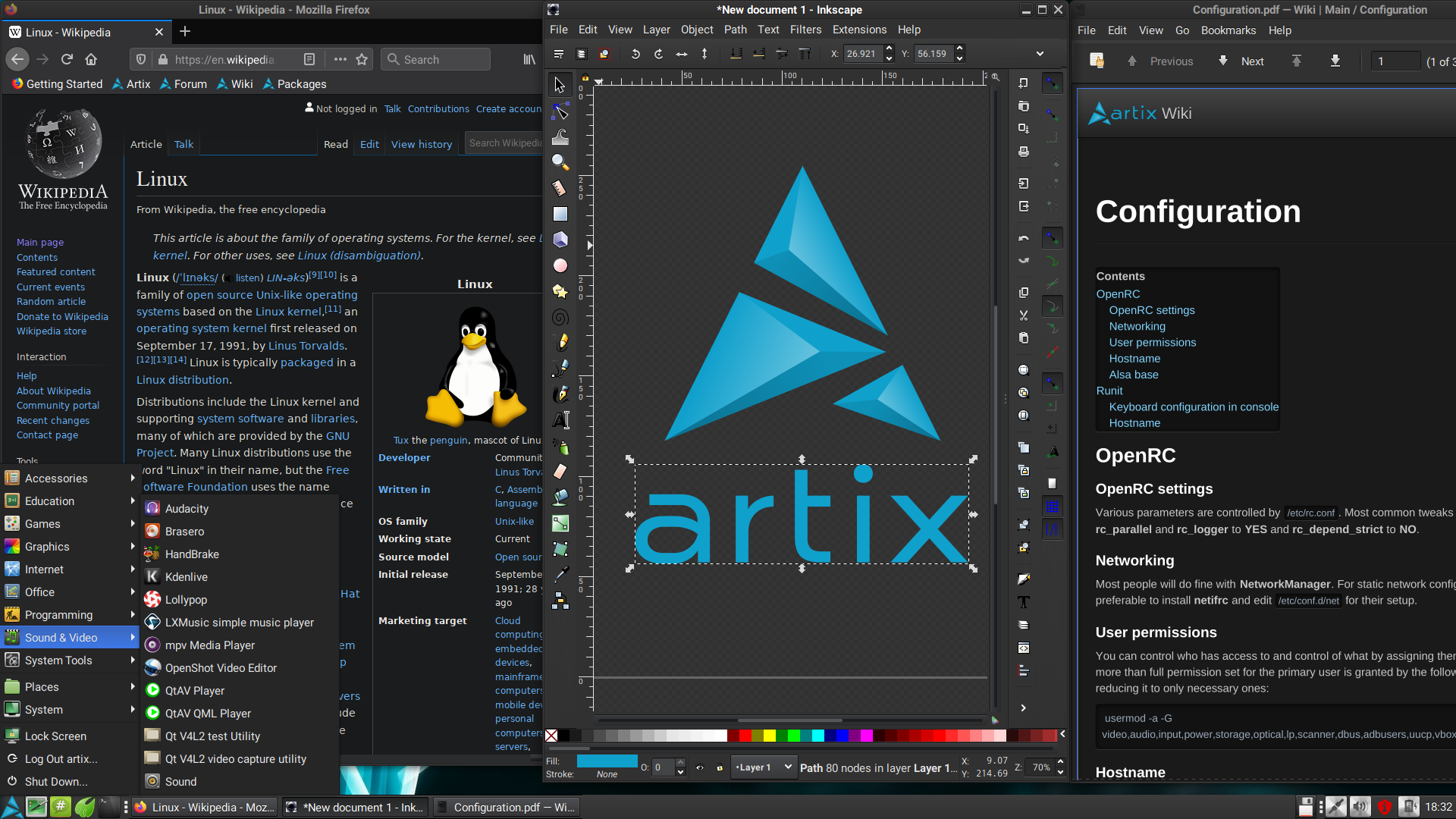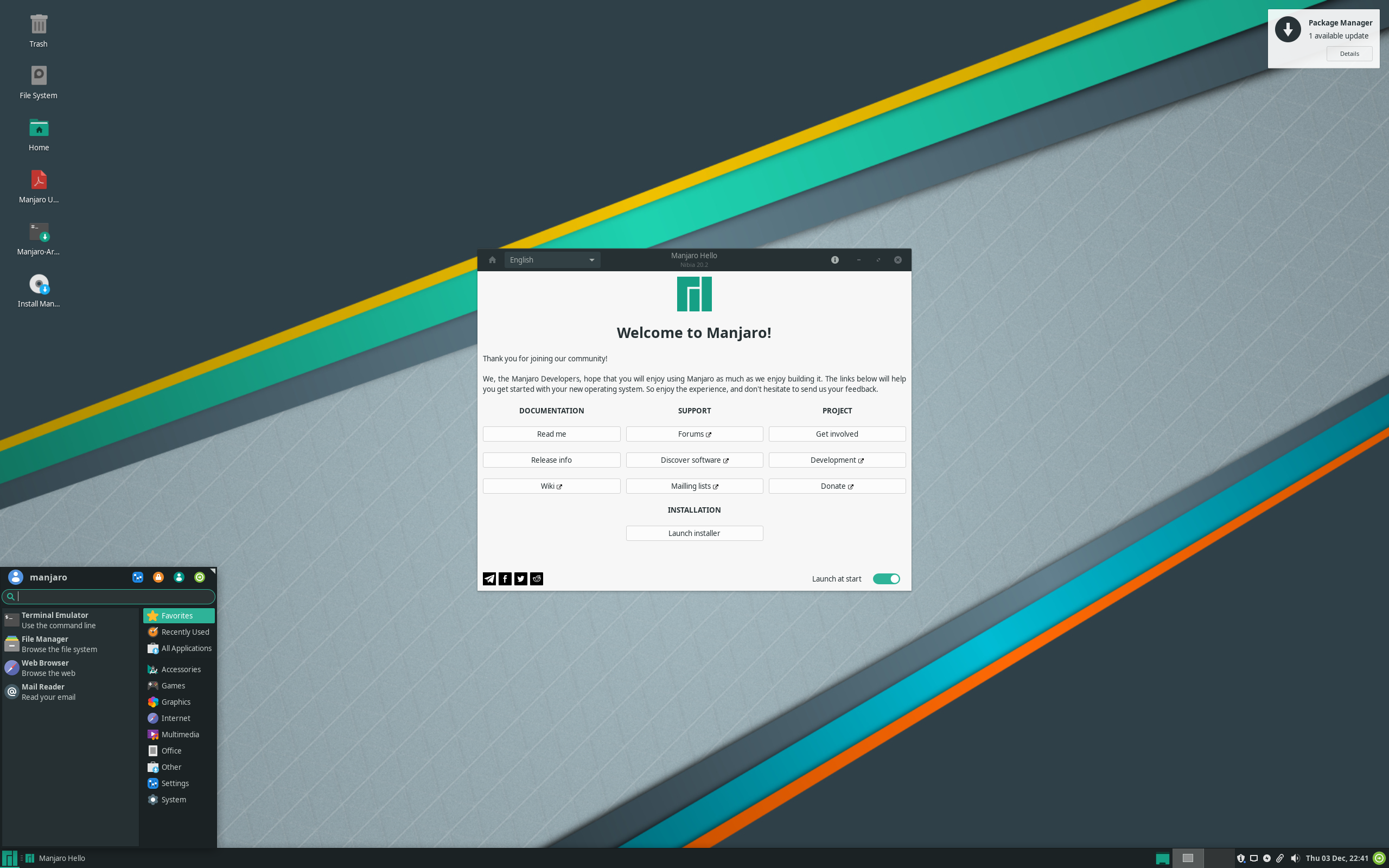|
Artix Linux
Artix Linux (or simply Artix ) is a rolling-release distribution based on Arch Linux that uses inits such as OpenRC, runit, s6, or Dinit, as opposed to Arch Linux's init systemd. Artix Linux has its own package repositories but, as a pacman-based distribution, can use packages from Arch Linux repositories or any other derivative distribution, even packages explicitly depending on systemd. The Arch User Repository (AUR) can also be used. Arch OpenRC began in 2012 and Manjaro OpenRC was subsequently developed alongside it. In 2017 these projects merged to create Artix Linux. Release history Artix initially offered two installation environments, a base command-line ISO image and the graphical Calamares installer based on LXQt desktop, with an i3 version following later. Those early versions featured the OpenRC init system. The latest installation media are available in a variety of desktop environments like LXDE, XFCE, MATE, Cinnamon and KDE Plasma 5. Additionally, two un ... [...More Info...] [...Related Items...] OR: [Wikipedia] [Google] [Baidu] |
Linux
Linux ( or ) is a family of open-source Unix-like operating systems based on the Linux kernel, an operating system kernel first released on September 17, 1991, by Linus Torvalds. Linux is typically packaged as a Linux distribution, which includes the kernel and supporting system software and libraries, many of which are provided by the GNU Project. Many Linux distributions use the word "Linux" in their name, but the Free Software Foundation uses the name "GNU/Linux" to emphasize the importance of GNU software, causing some controversy. Popular Linux distributions include Debian, Fedora Linux, and Ubuntu, the latter of which itself consists of many different distributions and modifications, including Lubuntu and Xubuntu. Commercial distributions include Red Hat Enterprise Linux and SUSE Linux Enterprise. Desktop Linux distributions include a windowing system such as X11 or Wayland, and a desktop environment such as GNOME or KDE Plasma. Distributions intended for ser ... [...More Info...] [...Related Items...] OR: [Wikipedia] [Google] [Baidu] |
Arch Linux
Arch Linux () is an independently developed, x86-64 general-purpose Linux distribution that strives to provide the latest stable versions of most software by following a Rolling release, rolling-release model. The default installation is a minimal base system, configured by the user to only add what is purposely required. #Pacman, Pacman, a package manager written specifically for Arch Linux, is used to install, remove and update Package (package management system), software packages. Arch Linux uses a Rolling release, rolling release model, meaning there are no "major releases" of completely new versions of the system; a regular system update is all that is needed to obtain the latest Arch software; the installation images released every month by the Arch team are simply up-to-date snapshots of the main system components. Arch Linux has comprehensive documentation, consisting of a community-run wiki known as the ArchWiki. History Inspired by CRUX, another minimalist distrib ... [...More Info...] [...Related Items...] OR: [Wikipedia] [Google] [Baidu] |
Qt (software)
Qt (pronounced "cute") is cross-platform software for creating graphical user interfaces as well as cross-platform applications that run on various software and hardware platforms such as Linux, Windows, macOS, Android or embedded systems with little or no change in the underlying codebase while still being a native application with native capabilities and speed. Qt is currently being developed by The Qt Company, a publicly listed company, and the Qt Project under open-source governance, involving individual developers and organizations working to advance Qt. Qt is available under both commercial licenses and open-source GPL 2.0, GPL 3.0, and LGPL 3.0 licenses. Purposes and abilities Qt is used for developing graphical user interfaces (GUIs) and multi-platform applications that run on all major desktop platforms and most mobile or embedded platforms. Most GUI programs created with Qt have a native-looking interface, in which case Qt is classified as a ''widget toolkit''. ... [...More Info...] [...Related Items...] OR: [Wikipedia] [Google] [Baidu] |
Desktop Environment
In computing, a desktop environment (DE) is an implementation of the desktop metaphor made of a bundle of programs running on top of a computer operating system that share a common graphical user interface (GUI), sometimes described as a graphical shell. The desktop environment was seen mostly on personal computers until the rise of mobile computing. Desktop GUIs help the user to easily access and edit files, while they usually do not provide access to all of the features found in the underlying operating system. Instead, the traditional command-line interface (CLI) is still used when full control over the operating system is required. A desktop environment typically consists of icons, windows, toolbars, folders, wallpapers and desktop widgets (see Elements of graphical user interfaces and WIMP). A GUI might also provide drag and drop functionality and other features that make the desktop metaphor more complete. A desktop environment aims to be an intuitive way for the user to ... [...More Info...] [...Related Items...] OR: [Wikipedia] [Google] [Baidu] |
I3 (window Manager)
i3 is a tiling window manager designed for X11, inspired by wmii and written in C. It supports tiling, stacking, and tabbing layouts, which it handles dynamically. Its configuration is achieved via a plain text file and extending i3 is possible using its Unix domain socket and JSON based IPC interface from many programming languages. Like wmii, i3 uses a control system very similar to that of vi and Vim. By default, window focus is controlled by what the documentation refers to as the 'Mod1' key (Alt key/Windows key) plus the right-hand home row keys (Mod1+J,K,L,Semicolon), while window movement is controlled by the addition of the Shift key (Mod1+Shift+J,K,L,Semicolon). Design goals i3's primary design goals are to possess well-written, documented code that encourages user contribution; to use XCB instead of Xlib; to implement multi-monitor features correctly, so that each workspace is assigned to a virtual screen, and monitor additions and removals are non-destructiv ... [...More Info...] [...Related Items...] OR: [Wikipedia] [Google] [Baidu] |
Calamares (software)
Calamares is a free and open-source independent and distro-agnostic system installer for Linux distributions. Calamares is used by Garuda Linux, Manjaro, Netrunner, KaOS, KDE neon, Lubuntu, Sabayon Linux, Chakra, EndeavourOS, Peppermint OS, Artix Linux, the ''Live'' medium of Debian, and several less known Linux distributions. It also has been used to automate the installation of command line distributions and to make custom distros. Development was started in 2014 by Manjaro community member Teo Mrnjavac “with support from Blue Systems” and then picked up by KaOS. Configuration Calamares is very configurable using a mix of code modules and built in tools. Many distro makers add branding to the installer. However, some distro makers opt to leave the installer to its default look feel and options. See also * Anaconda * YaST * Debian-Installer * Ubiquity Ubiquity is a synonym for omnipresence, the property of being present everywhere. Ubiquity may also refer to: * ... [...More Info...] [...Related Items...] OR: [Wikipedia] [Google] [Baidu] |
Artix Community GTK-Qt 2020-02 , a Linux distribution
{{disambiguation, geo ...
Artix may refer to: * Artix, Ariège, a commune in France * Artix, Pyrénées-Atlantiques, a commune in France * Artix ESB, software product of IONA Technologies * Artix Entertainment, an independent video game developer *Artix Linux Artix Linux (or simply Artix ) is a rolling-release distribution based on Arch Linux that uses inits such as OpenRC, runit, s6, or Dinit, as opposed to Arch Linux's init systemd. Artix Linux has its own package repositories but, as a pacman-ba ... [...More Info...] [...Related Items...] OR: [Wikipedia] [Google] [Baidu] |
Artix Community FF-Inkscape 2020-02 , a Linux distribution
{{disambiguation, geo ...
Artix may refer to: * Artix, Ariège, a commune in France * Artix, Pyrénées-Atlantiques, a commune in France * Artix ESB, software product of IONA Technologies * Artix Entertainment, an independent video game developer *Artix Linux Artix Linux (or simply Artix ) is a rolling-release distribution based on Arch Linux that uses inits such as OpenRC, runit, s6, or Dinit, as opposed to Arch Linux's init systemd. Artix Linux has its own package repositories but, as a pacman-ba ... [...More Info...] [...Related Items...] OR: [Wikipedia] [Google] [Baidu] |
Manjaro
Manjaro ( ) is a free and open-source Linux distribution based on the Arch Linux operating system that has a focus on user-friendliness and accessibility. It uses a rolling release update model and Pacman as its package manager. It is developed mainly in Austria, France and Germany. History Manjaro was first released on July 10, 2011. By mid 2013, Manjaro was in the beta stage, though key elements of the final system had all been implemented such as: a GUI installer (then an Antergos installer fork); a package manager (Pacman) with its choice of frontends; Pamac (GTK) for Xfce desktop and Octopi ( Qt) for its Openbox edition; MHWD (Manjaro Hardware Detection, for detection of free & proprietary video drivers); and Manjaro Settings Manager (for system-wide settings, user management, and graphics driver installation and management). GNOME Shell support was dropped with the release of version 0.8.3 in 2012. However, efforts within Arch Linux made it possible to restart the Cinn ... [...More Info...] [...Related Items...] OR: [Wikipedia] [Google] [Baidu] |
Arch User Repository
Arch Linux () is an independently developed, x86-64 general-purpose Linux distribution that strives to provide the latest stable versions of most software by following a rolling-release model. The default installation is a minimal base system, configured by the user to only add what is purposely required. Pacman, a package manager written specifically for Arch Linux, is used to install, remove and update software packages. Arch Linux uses a rolling release model, meaning there are no "major releases" of completely new versions of the system; a regular system update is all that is needed to obtain the latest Arch software; the installation images released every month by the Arch team are simply up-to-date snapshots of the main system components. Arch Linux has comprehensive documentation, consisting of a community-run wiki known as the ArchWiki. History Inspired by CRUX, another minimalist distribution, Judd Vinet started the Arch Linux project in March 2002. The name was ... [...More Info...] [...Related Items...] OR: [Wikipedia] [Google] [Baidu] |
Systemd
systemd is a software suite that provides an array of system components for Linux operating systems. Its main aim is to unify service configuration and behavior across Linux distributions; Its primary component is a "system and service manager"—an init system used to bootstrap user space and manage user processes. It also provides replacements for various daemons and utilities, including device management, login management, network connection management, and event logging. The name ''systemd'' adheres to the Unix convention of naming daemons by appending the letter ''d''. It also plays on the term "System D", which refers to a person's ability to adapt quickly and improvise to solve problems. Since 2015, the majority of Linux distributions have adopted systemd, having replaced other init systems such as SysV init. It has been praised by developers and users of distributions that adopted it for providing a stable, fast out-of-the-box solution for issues that had existed i ... [...More Info...] [...Related Items...] OR: [Wikipedia] [Google] [Baidu] |

.jpg)



